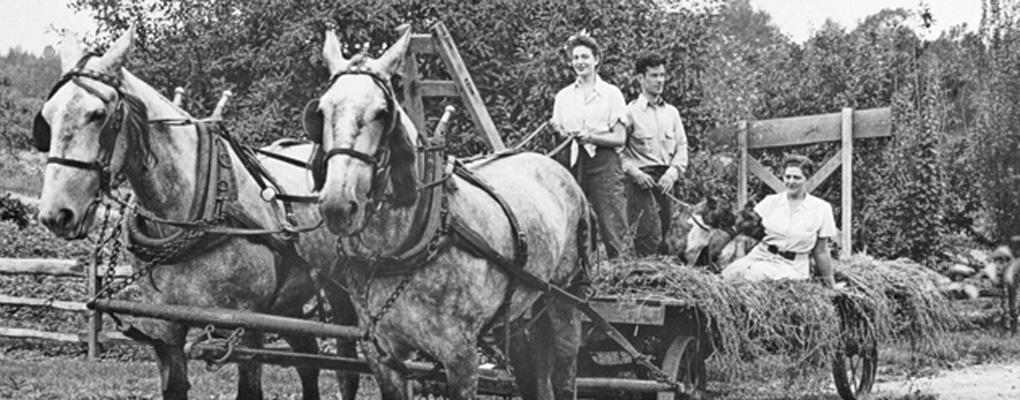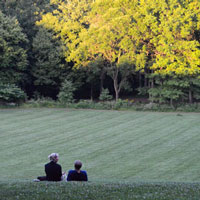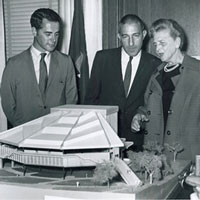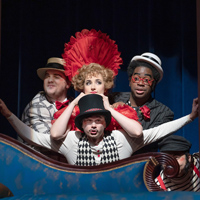 Mrs. Shouse (seated) on a ride through her farm, the site of today’s Filene Center and Wolf Trap National Park for the Performing Arts.
Mrs. Shouse (seated) on a ride through her farm, the site of today’s Filene Center and Wolf Trap National Park for the Performing Arts.
A vision for arts, nature, and refreshing retreat from city life
 Patrons today enjoy nature preserved.
Patrons today enjoy nature preserved.
When Diana Ross, The Avett Brothers, Wynton Marsalis, Halsey, Sting, Jennifer Hudson, or the National Symphony Orchestra take the stage at Wolf Trap, they are standing on what used to be a working farm owned by a visionary woman, Catherine Filene Shouse.
When she founded Wolf Trap Farm Park in 1966, Mrs. Shouse was already 71 years old. She was a highly decorated public servant with deep roots in the nation’s capital and with international leaders—having worked with every president from Woodrow Wilson to Bill Clinton.
Mrs. Shouse began acquiring farmland outside of Washington, D.C. in 1930 for use as a refuge from city life. By 1956, she had 168 acres and was growing a variety of crops, as well as breeding horses and dogs.
Most importantly, the farm served as a gathering place for family and friends, as well as international dignitaries and members of the Washington, D.C. social and political community, where they enjoyed dinners, parties, dances, carnivals, and simple nature walks in the country.
 (L-R) Architect Edward Knowles, Secretary of the Interior Stewart L. Udall, and Mrs. Shouse review the architectural model of the Filene Center.
(L-R) Architect Edward Knowles, Secretary of the Interior Stewart L. Udall, and Mrs. Shouse review the architectural model of the Filene Center. A gift to the nation
In 1966, Catherine Filene Shouse decided to donate 100 acres of her farm to the U.S. government, as well as funds to build a large outdoor amphitheater—now fondly known as the Filene Center.
Mrs. Shouse’s goal was to protect the land from encroaching roads and development, as well as to create a place where the arts could be enjoyed in harmony with nature.
That same year, Congress accepted Mrs. Shouse's gift and designated it as Wolf Trap Farm Park for the Performing Arts.
Construction on the amphitheater subsequently began and the Filene Center was finally completed in 1971. In 2002, Wolf Trap Farm Park was officially renamed to Wolf Trap National Park for the Performing Arts.
Wolf Trap is operated by a public/private partnership in which the National Park Service and Wolf Trap Foundation, a nonprofit established in 1968, work together to provide performing arts and education experiences at Wolf Trap National Park.
Why the name?
Records from as early as 1632 show wolves were once highly prevalent in the region. Eventually the wolf population became less common, but by the 18th-century, “Wolftrap” was the official name of the area.
When Mrs. Shouse first purchased her land, with a mile and a half of Wolf Trap Run flowing through it, she chose to emphasize the area’s history by naming it Wolf Trap Farm. The creek remains today, and after several years, Wolf Trap Farm became known as Wolf Trap National Park for the Performing Arts. Today, this name reminds us that here the arts are rooted in nature.
A favorite among artists from day one
The inaugural performances at the Filene Center on July 1-2, 1971 featured Julius Rudel conducting the National Symphony Orchestra with pianist Van Cliburn and New York City Opera star Norman Treigle, ”The President’s Own” United States Marine Band, The Choral Arts Society of Washington, and the Madison Madrigal Singers.
Since that time, Wolf Trap’s Filene Center has attracted world-class artists from every genre of the performing arts—many of whom return each summer because of their love for this extraordinary setting.
A second gift to DC-area arts-lovers
In 1981, Mrs. Shouse donated another venue to house smaller acts year-round, The Barns at Wolf Trap, which is managed by the nonprofit Wolf Trap Foundation.
Mrs. Shouse had two 18th-century barns from New York relocated to Virginia and rebuilt in a manner that kept their rustic charm, but offered superb acoustics and amenities.
Together, the two structures now make up The Barns, which presents more than 80 performances every fall through spring including the Chamber Music at The Barns series, and during the summer months, is home to Wolf Trap Opera.
Commitment to education
Wolf Trap has been committed to arts education from the start.
 Wolf Trap Opera alumni can be found in top opera houses across the country and abroad.
Wolf Trap Opera alumni can be found in top opera houses across the country and abroad.
Since 1971, Wolf Trap Foundation has offered training for musicians in a variety of disciplines, most notably for opera singers.
Wolf Trap Opera was founded in 1971 and has since emerged as one of the nation’s premier residency programs for young singers.
In 1981, Wolf Trap Foundation made the decision to invest heavily in arts education for children up to first grade—particularly in disadvantaged areas. This decision was born out of a desire to use the performing arts to better engage children at the earliest stages of their development.
The Wolf Trap Institute for Early Learning Through the Arts was established through a grant from the Head Start Bureau of the U.S. Department of Health and Human Services.
In the decades since, Wolf Trap Institute has become a national leader in arts and early childhood education, with affiliate programs across the country and around the world.
Celebrating 50 years
In 2021, Wolf Trap welcomes audiences back to the Park to celebrate the 50th Anniversary Season. Wolf Trap looks to the next 50 years with a commitment to serving the community, furthering educational opportunities, and creating excellent performing arts experiences for future generations.